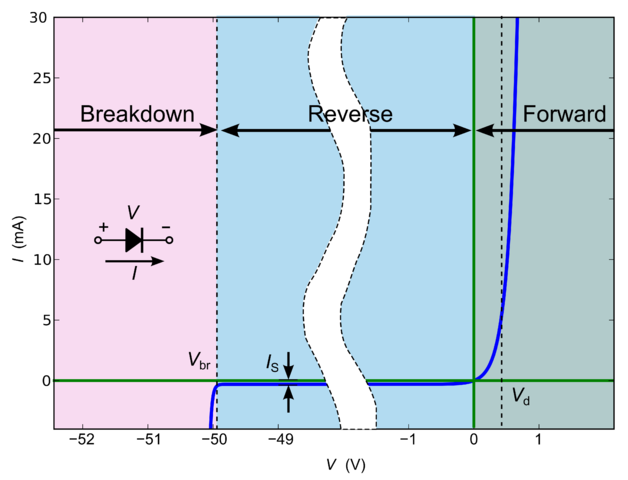For many designers, diodes seem like the simplest part of your circuits. After all, they just block current from passing in one direction, right? Well, it turns out there's a lot more to diodes than meets the eye! This blog entry is based on a great chapter I read in The Circuit Designer's Companion and in it we'll be exploring some of the basic characteristics of diodes, the basic types of diodes, and some fun diode facts!

Really no discussion of diodes is complete without a little semiconductor physics. However, I'm actually going to split that into a second blog entry. Here we'll discuss the what and how of diodes and next time, we'll delve into the why. So fasten your seat belts because we're about to take a trip into the wonderful world of these two terminal semiconductor devices!
Diode Characteristics
 Image created Wikipedia author Hldsc
Image created Wikipedia author Hldsc
Forward Bias
The best way to understand the behavior of diodes is by looking at the I-V curve like the one in the figure above. When the diode is forward biased, the current-voltage relationship is exponential and is modeled by the Ebers-Moll equation: \(I_{F} = I_{S}[\exp(\frac{V_{F}q}{kT})-1]\). In this equation, \(I_{F}\) is the forward current, \(I_{S}\) is the saturation current, \(q\) is the electron charge, and \(k\) is Boltzmann's constant.
In practice what this equation means is that when current is passing through the diode, the voltage drop across it is more or less constant. The value of this forward voltage drop is dependent on the device as we'll discuss below. One thing to be careful of is if the current in the diode is very low (like if there's a very large resistor in series with the diode), the V-I slope will not be flat.
Temperature variability
One other interesting thing about the Ebers-Moll equation is that the I-V relationship is temperature dependent. Of course, when current is flowing in a diode, it warms up, further complicating our ability to perfectly model a diode's behavior. One nice side effect of this temperature dependence is that it's common to all p-n junctions so you can actually use diodes to compensate for temperature dependence in BJT circuits.
Reverse Bias
When you reverse bias a diode, the expectation is that it will not allow any current to pass through it until you hit the breakdown voltage. In reality, this is not entirely true. There is a small leakage current that passes through a reverse biased diode. The current is pretty constant with voltage (up until the breakdown voltage), but it increases by about a factor of two for every 10 degrees C increase in temperature.
Breakdown
As the reverse voltage increases, the electric field increases as well. Eventually, there comes a point where the P-N junction can't take the electric field anymore and current begins increasing rapidly. This is known as the breakdown voltage. If that current is relatively constant, the power dissipated in the diode will likely destroy it. However, it's possible to have transient voltage spikes that leave a diode unharmed even after it has gone into breakdown.
Switching
Speaking of transients, if you've ever used an asynchronous buck converter, you know that diodes feature heavily as switching elements. However, what makes a diode perform well at high frequencies? The first thing that hampers a diode's switching ability is the parasitic cap that's formed by the charge on either side of the depletion region. As the figure below shows, the larger the reverse bias, the larger the depletion region, and the lower the parasitic capacitance.
 Given what we know about this parasitic capacitance, we can image that when a diode switches from reversed biased to forward biased, the parasitic cap first has to be discharge. This is called turn-on time and it turns out that it's a lot faster than the turn off time.
Given what we know about this parasitic capacitance, we can image that when a diode switches from reversed biased to forward biased, the parasitic cap first has to be discharge. This is called turn-on time and it turns out that it's a lot faster than the turn off time.
When a diode turns off or goes from being reversed biased to forward biased, all the minority charge carriers have to get swept out first. For various semiconductor physics reasons which will be discussed in the future, this "reverse recovery" time is slow. A number of fast recovery diodes have been developed to try to improve this.
Types of Diodes
There are a large number of diodes, but some of the most common types you'll encounter are P-N junction, schottky and zener diodes. Here's a quick table comparing these diodes and their use cases.

And here are the typical symbols engineers use to represent these diodes.
Symbols

Zener Diodes
Zener diodes are particularly interesting because due to their silicon construction, they have a tightly controlled breakdown voltage, so they can be used to pass current in both the forward and reverse regions. In the same way that forward voltage changes rapidly at microcurrents, you also shouldn't operate a zener diode at very low currents and expect a constant clamping voltage. However, if you're operating past the "knee" current, zener diodes are a great tool for clamping voltages for circuit protection.